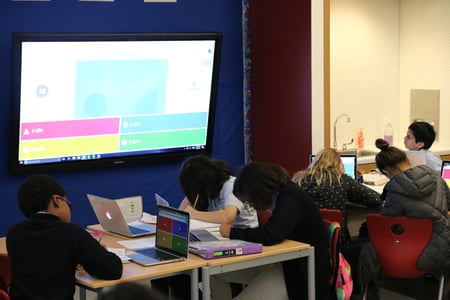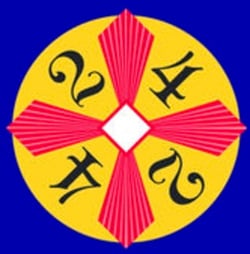HOW GAMES CAN HONE SKILLS AND SPARK DISCOVERY
January 26, 2017 Richard Getzel Innovation, Education, GEMS World Academy Chicago, Games, Mathematics
 GEMS Middle School math teacher Richard Getzel writes this blog post about how the use of games in math class can help students master math concepts and hone their critical-thinking skills.
GEMS Middle School math teacher Richard Getzel writes this blog post about how the use of games in math class can help students master math concepts and hone their critical-thinking skills.
Engagement in the classroom can take many forms — a meaningful hands-on activity, the investigation of a key concept or the application of skills and content to real-life situations. As I have transformed from a fresh-faced 20-something teacher into a grizzled, middle-aged veteran, I have come to appreciate the value of incorporating games in the math classroom.
One of my early reservations about games stemmed from my innate skepticism about “gimmicky” teaching. I am, first and foremost, a math teacher, and the classroom is a laboratory for learning before it is a laboratory for fun. This does not mean that my classroom door is the entrance to a dystopian world where fun goes to die; it does mean that revelry is lower on the totem pole of priorities in my class.
 Falling for educational fads and injecting fun-but-purposeless activities into class are pitfalls that an educator should avoid. However, I have become more accommodating of the idea that games, when properly implemented, can promote learning in a meaningful way. I am reminded of the proclamation on the old Highlights magazines that littered my bedroom when I was a kid: “Fun with a Purpose!” This is the motto that guides me now when I think about incorporating a game into a unit.
Falling for educational fads and injecting fun-but-purposeless activities into class are pitfalls that an educator should avoid. However, I have become more accommodating of the idea that games, when properly implemented, can promote learning in a meaningful way. I am reminded of the proclamation on the old Highlights magazines that littered my bedroom when I was a kid: “Fun with a Purpose!” This is the motto that guides me now when I think about incorporating a game into a unit.
One of the most strategic moments to “gamify” the classroom occurs when it is time to review for a test. Review, while necessary to reinforce the skills and concepts of the unit, can sometimes be a tedious exercise. The content is no longer fresh, and the novelty of discovering new math procedures and the ideas underlying them has worn off. In this digital age, the online landscape abounds in games, but this means that finding an appropriate one can be a daunting task. Enter Kahoot! — an online gaming platform where all students simply log in and lock in their answers to review questions on the iPad. Students are rewarded points based on their speed, but actually, the system rewards more points to students who provide more consecutive correct answers. Every student knows his or her place among the class, but only the top three performers appear on the MondoBoard. In my perspective, games should be fun and educational, but not an avenue through which students may be embarrassed.
It is at times like these where I stress that “this is only a game” and remind students that mistakes are simply opportunities for learning, a philosophy that is deeply embedded in the culture here at GEMS. What sets Kahoot! apart from so many other programs is its immediate feedback. At the conclusion of every question, a screen pops up revealing how many students got the question right and how many students erred in their solution. Equipped with this knowledge, I can dedicate more time to reviewing and discussing questions that were the most problematic for my students. I can avoid wasting time on problems that students have already mastered, thus maximizing the effectiveness of my review.
Of course, games are not just for assessment review. Integer Bingo and Fraction-Decimal-Percent Bingo have become staples in my Middle School classroom. Procedural fluency is very important in math, but this does not always have to take the form of a worksheet with an interminable list of questions. Students get excited about finding the correct solution so they can fill up their bingo boards, and in the process, they are getting vital practice in calculation, as well as representing numbers in their different forms.
One of the most enriching games I have adopted in my math classroom is called 24. This game presents students with a card that has four numbers, all of them digits from 1 to 9. Using two or more of the four basic math operations, students combine the numbers on the card in a way that leads to 24 as the solution. Students might have to use addition twice an d division once, or they might use multiplication, subtraction and division. Any combination of the operations is permitted, as long as 24 is the final solution. It is a game that promotes critical thinking and algebraic reasoning (backwards thinking), but it also can be a useful way to reinforce the order of operations.
d division once, or they might use multiplication, subtraction and division. Any combination of the operations is permitted, as long as 24 is the final solution. It is a game that promotes critical thinking and algebraic reasoning (backwards thinking), but it also can be a useful way to reinforce the order of operations.
Consider the 24 card included with this post as an example: Writing out the solution 4 x 2 – 2 x 4, when evaluated from left to right, would yield the answer 24 ("four times two, minus two, times four"), but this disregards the order of operations. The answer to this expression is actually 0. Students are challenged to write an expression that obeys the order of operations. For example, (4 x 2 – 2) x 4, would correctly bring us to 24. This is another activity that reinforces critical math skills while engaging students in an exciting contest.
Research backs up my experience with games. Robert Marzano, author of The Art and Science of Teaching, has been involved in more than 60 studies designed to reveal the effects of games on student achievement, and they demonstrate that, on average, the consistent use of academic games in the classroom correlates with a 20-percentile-point gain in student achievement. The National Council of Teachers of Mathematics, meanwhile, wholeheartedly endorses the implementation of games in the math classroom, concluding that:
- Playing games encourages strategic mathematical thinking as students find different strategies for solving problems and deepen their understanding of numbers.
- When played repeatedly, games support students’ development of computational fluency.
- Games present opportunities for practice, often without the need for teachers to provide the problems. Teachers can then observe or assess students and work with individuals or small groups of students.
The games that I have enumerated represent just a sample of the games that have been played in my classroom. Do you know of any fun and educational math games? Let your child’s teacher know, because you just may be holding the key to understanding for many students in your child’s learning community.